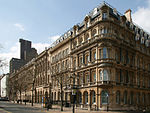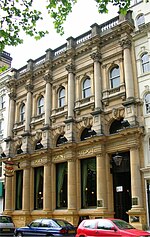Birmingham Snow Hill railway station

Birmingham Snow Hill, also known as Snow Hill station, is a railway station in Birmingham City Centre. It is one of the three main city-centre stations in Birmingham, along with Birmingham New Street and Birmingham Moor Street. Snow Hill was once the main station of the Great Western Railway in Birmingham and, at its height, it rivalled New Street station with competitive services to destinations including London Paddington, Wolverhampton Low Level, Birkenhead Woodside, Wales and South West England. The station has been rebuilt several times since the first station at Snow Hill, a temporary wooden structure, was opened in 1852; it was rebuilt as a permanent station in 1871 and then rebuilt again on a much grander scale during 1906–1912. The electrification of the main line from London to New Street in the 1960s saw New Street favoured over Snow Hill, most of whose services were withdrawn in the late 1960s. This led to the station's eventual closure in 1972 and its demolition five years later. After fifteen years of closure, a new Snow Hill station, the present incarnation, was built; it reopened in 1987. Today, most of the trains using Snow Hill are local services on the Snow Hill Lines, operated by West Midlands Railway, serving Worcester Shrub Hill, Kidderminster, Stourbridge Junction, Stratford-upon-Avon and Solihull. The only long-distance service using Snow Hill is to and from London Marylebone, operated by Chiltern Railways via the Chiltern Main Line. The present Snow Hill station has three platforms for National Rail trains. When it was originally reopened in 1987, it had four, but one was later converted in 1999 for use as a terminus for West Midlands Metro trams on the line from Wolverhampton. This tram terminus closed in October 2015, in order for the extension of the West Midlands Metro through Birmingham city centre to be connected; this included a dedicated embankment for trams alongside the station and included a new through stop serving Snow Hill.
Excerpt from the Wikipedia article Birmingham Snow Hill railway station (License: CC BY-SA 3.0, Authors, Images).Birmingham Snow Hill railway station
Livery Street, Birmingham Digbeth
Geographical coordinates (GPS) Address Nearby Places Show on map
Geographical coordinates (GPS)
| Latitude | Longitude |
|---|---|
| N 52.483 ° | E -1.899 ° |
Address
Livery Street
B3 2BH Birmingham, Digbeth
England, United Kingdom
Open on Google Maps









